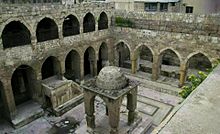Central Synagogue of Aleppo
According to tradition, the foundation for the Great Synagogue in Aleppo was constructed by King David's General, Joab ben Zeruiah, (circa 950 BCE), after his conquest of the city.
During the Mongol period (13th century), the synagogue was one of six designated places of refuge in the city, but was destroyed during Tamerlane's subjugation of Aleppo in 1400.
On the right hand of the entrance, is a kind of great hall, which they make use of for their service in the winter when it is cold or rains; as they do of the court in summer and fair weather: In the middle of the court four pillasters support a cupoletta, under which in a high and decent place, like our altar; lies the volume of the Law, and there also their doctor and principal rabbi stands reading in a kind of musical tone, to whom all the people alternately answer:...Another account by Elkan Nathan Adler in his book Jews in Many Lands published in 1905 records: The chief synagogue is very ancient and has many peculiarities.
The latter is on a chapel stated to have been erected by Mar Ali ben Nathan b. Mebasser b. HaAram....Hebrew inscription... Only four letters are starred, so that the date is probably 1145, sel.=834.
The chief peculiarity of the Aleppo synagogue is a raised pulpit called the Kiseh Eliyahu approached by a flight of some twenty steps and still used for the solemnization of a Brit milah.
Over the synagogue there is a yeshivah and in a secret chamber in the eaves of the roof of one of the side chapels is the genizah.It had later on undergone a series of modifications until its destruction during the violent attacks against Jews by the local population in December 1947.
The building has been badly damaged, but the synagogue still stands and is under full supervision and protection by the Syrian government, although there are no worshippers utilizing it.
An example of such a trip took place on 1 June 2008, when a minyan for the morning services with the Kaddish and Kohanim was conducted by the visitors and former members of the synagogue.
The synagogue edifice was divided into three main sections: a central courtyard that separated the western wing, where in modern times the musta'arabi community used to worship, from the eastern section built at a later time during the 16th century and which served as Beth Midrash and prayer hall of the "Francos", i.e. Sephardi Jews that settled in the town after the Spanish exile and other European Jews that happened to sojourn in Aleppo.



